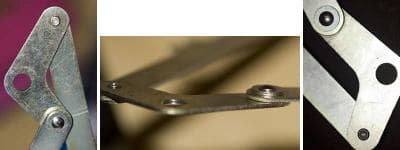
-----
Plating linkages 'as assemblies'?
July 29, 2008
I am in the process of restoring a 40-year-old record player. The front panel contains three dial type knobs connect to mechanical linkages (made of steel). These operate various functions such as selecting the record speed (45/33/78), on/off and 'pitch' control. I am reliably informed that the original coating contains cadmium and therefore needs a lot of 'respect'.
The 'bars' that form the linkages are joined via a type of rivet, which allows the two bars to swivel. Some of these bars/rivets have suffered some corrosion damage and it is this that I need to rectify. Unfortunately, I have yet to find a suitable replacement for the original rivets so I am hoping to leave these in place during the restoration.
From my research so far, I am planning the following, but ask if this is either possible or desirable:
The linkages have been removed but the rivets are still in place. I therefore have various assemblies that consist of two or more bars, connected by rivets.

I plan to remove the corrosion using an electrolytic bath
(www.htpaa.org.au/article-electro.php).
Once the corrosion is removed, I hope to be able to re-plate these parts 'as assemblies' without removing the rivets. It has been suggested that either nickel or zinc plating would be suitable.
Questions:
Is it indeed possible to plate these parts 'as assemblies'?
If I do so, will I maintain the flexibility in the joints (this is obviously critical to their functionality)?
What would be the better material for plating?
I really hope someone can point me in the right direction as I'm getting lots of conflicting information.
Thanks in advance for any help.
Hobbyist - Cape Town, South Africa
July 29, 2008
Hi, Bill. Electroplating will not have the necessary throwing power to plate the "shaded" area if one link of the linkage shades another. However, if you can make provision for moving the linkage one or more times during plating to "unshade" the area, it should be okay. That same lack of throwing power means that there won't be much metal deposited on the rivet pin or the IDs of the holes the pin goes through. So if the linkages can be moved a few times during plating I think it will all work.
Regards,

Ted Mooney, P.E.
Striving to live Aloha
finishing.com - Pine Beach, New Jersey
Ted can be retained for immediate
answers or long term project help
Your best shot is electroless nickel, but you will need a person flexing the parts every 5 - 10 min in the HOT bath (not outside) for 1 to 2 hours.
James Watts- Navarre, Florida
July 31, 2008
July 31, 2008
That sounds really difficult, Jim -- how about brush plating with zinc?
Regards,

Ted Mooney, P.E.
Striving to live Aloha
finishing.com - Pine Beach, New Jersey
Ted can be retained for immediate
answers or long term project help
You will not get any plating in some portion of the joint and it will rust there regardless of the amount of rinsing.
Possibly polishing it and using carnuba wax or beeswax ⇦ on eBay or Amazon [affil link] would work. Possibly that "never rust" finish that one of the advertisers has.
James Watts- Navarre, Florida
August 1, 2008
Seeing as it's for linkages and indoor use, protected within a machine, and is plated with a sacrificial material, don't you think a typical light coating of Machinery Oil [affil link] would be enough, Jim?
Regards,

Ted Mooney, P.E.
Striving to live Aloha
finishing.com - Pine Beach, New Jersey
Ted can be retained for immediate
answers or long term project help
August 1, 2008
Q, A, or Comment on THIS thread -or- Start a NEW Thread